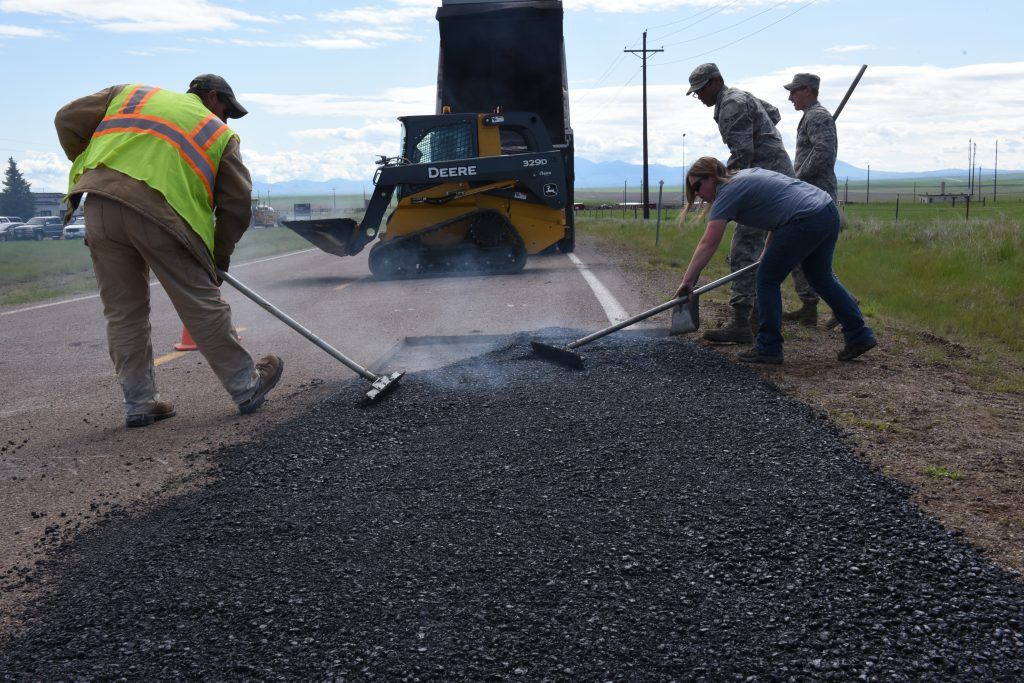Boost the Feel And Look of Your Residential Or Commercial Property with Specialist Commercial Parking Great Deal Paving
Boost the Feel And Look of Your Residential Or Commercial Property with Specialist Commercial Parking Great Deal Paving
Blog Article
Unlocking the Keys of Warm Mix Asphalt Innovation
Exploring the midsts of hot mix asphalt technology uncovers a globe where precise solutions and meticulous processes converge to form our roads and facilities. The fusion of binders, fillers, and accumulations isn't just a construction task however a strategic orchestration of resilience and efficiency. As we peer right into the detailed dance of components, a tapestry of strength and sustainability unfolds. But what lies beneath this surface of asphaltic proficiency, and what secrets wait to be unveiled in the realm of paving technologies?
Relevance of Hot Mix Asphalt
Hot Mix Asphalt plays a critical function in contemporary infrastructure development due to its toughness and cost-effectiveness. As the most frequently made use of paving product for roadways, highways, and auto parking great deals, Warm Mix Asphalt offers a variety of benefits that add to its importance in construction tasks.
The longevity of Hot Mix Asphalt originates from its make-up, that includes accumulations, binder, and filler materials that are very carefully picked and blended to meet specific performance demands. This precise mix causes a adaptable and solid pavement that can sustain constant usage without substantial damage. Furthermore, Warm Mix Asphalt is 100% recyclable, further enhancing its sustainability and ecological advantages. In general, the importance of Warm Mix Asphalt in facilities growth can not be understated, as it proceeds to be a cornerstone of modern construction practices.
Parts of Asphalt Mixes
The structure of asphalt mixes is composed of thoroughly chosen accumulations, binder, and filler materials that are critical for attaining certain performance requirements. Aggregates are the primary component of asphalt mixes, offering strength and security. The binder, normally asphalt or asphalt concrete, holds the aggregates with each other and offers flexibility and sturdiness to the mix.
The combination and percentage of these parts play a substantial function in figuring out the high quality and efficiency of the asphalt mix. Designers meticulously design the mix to satisfy details requirements, considering variables like website traffic volume, climate conditions, and pavement life-span. Proper selection and balancing of accumulations, binder, and fillers are vital for creating durable, long-lasting asphalt pavements.
Combining and Production Techniques
:max_bytes(150000):strip_icc()/asphalt-worker-134249388-58cdf96f5f9b581d723f2f33.jpg)
When the accumulations are chosen, the binder, usually asphalt cement, is included in bind the materials with each other. The binder's high quality and quantity considerably impact the mix's strength, versatility, and resistance to ecological factors. Furthermore, fillers like hydrated lime or Portland concrete might be incorporated to boost details features of the asphalt mix, such as its workability or dampness resistance.
Throughout manufacturing, the aggregates and binder are heated, usually between 250-325 ° F(121-163 ° C ), to facilitate blending and make certain proper finish of the accumulations. The blending procedure has to be detailed to accomplish a homogeneous mix that advertises the desired performance attributes of the asphalt. Different methods, such as batch mixing or drum blending, are used to attain regular and top quality asphalt mixes for building and construction jobs.
Aspects Affecting Asphalt Performance
Factors affecting asphalt performance encompass a range of variables that affect the durability, longevity, and general quality of asphalt sidewalks. One vital element is the top quality of products used in the asphalt mix.

Environmental problems also affect asphalt efficiency. Temperature level variants, moisture infiltration, and web traffic lots can all influence the structural stability of the pavement. Style considerations, such as pavement thickness and drain, are necessary in ensuring the long-term performance of the asphalt pavement. By very carefully thinking about these professionals, engineers and aspects can maximize asphalt performance and enhance the service life of pavements.
Sustainable Practices in Asphalt Innovation

WMA allows for the production and placement of asphalt blends at reduced temperature levels compared to standard hot-mix asphalt, resulting in minimized power usage and greenhouse gas exhausts. The use of permeable asphalt mixes can aid mitigate stormwater runoff concerns by allowing water to infiltrate via the sidewalk and right into the ground, advertising natural water purification and recharge processes.
Final Thought
To conclude, hot mix asphalt modern technology plays an essential function in modern-day infrastructure development due to its resilience and cost-effectiveness. By thoroughly stabilizing components, employing proper mixing techniques, and thinking about various elements, designers can create high-grade asphalt mixes that stand up to hefty traffic tons and rough weather conditions. Embracing lasting methods, such as using recycled products and warm-mix innovations, additionally boosts the ecological friendliness of asphalt innovation.
Blending and manufacturing strategies in warm mix asphalt technology include the precise mix and handling of aggregates, binder, and fillers to develop a high-performance and resilient asphalt mix.Elements influencing asphalt efficiency encompass a range of variables that impact the resilience, long life, and overall quality of asphalt sidewalks. Sustainable read more techniques in asphalt innovation incorporate various campaigns intended at reducing the ecological impact of asphalt production and paving processes. By integrating reclaimed asphalt pavement (RAP) and recycled asphalt shingles (RAS) right into brand-new asphalt blends, the industry can substantially reduce the intake of raw products and power, while also reducing landfill waste.
WMA permits my company for the manufacturing and placement of asphalt blends at reduced temperature levels compared to standard hot-mix asphalt, resulting in decreased energy usage and greenhouse gas emissions.
Report this page